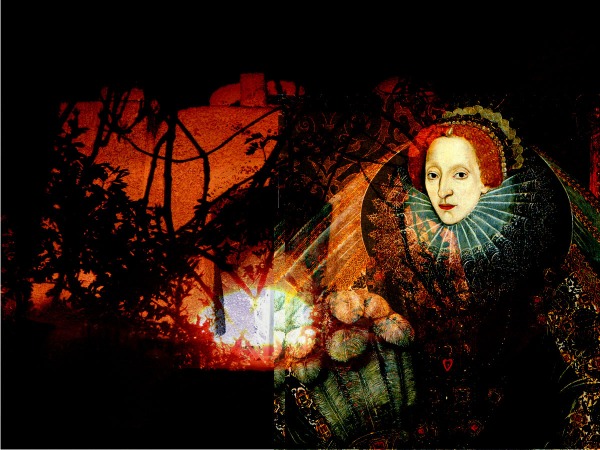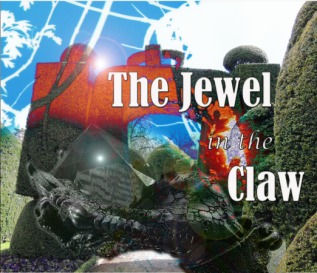
Is it possible to go back in time and see into the minds of monarchs who played a key role in a country’s development? Given it is so long ago, how difficult would it be to do this for the Elizabethan age?
This is our task for the Silent Eye’s spring workshop 2018: “The Jewel in the Claw’. The jewel is the emerging spirit of tolerance that Elizabeth, the self-styled virgin-queen, engendered; the claw is the nature of the forces of ignorance that still plague us in the twenty-first century every bit as much as they did in 1588, the year that the mighty Spanish Armada was defeated by a combination of English naval courage and our equally fabled weather; and Elizabeth I finally achieved a degree of security.
That security had been a long time coming: twenty-nine years, to be exact, the length of time between her coronation, in 1559, and the sanctuary created by the failure of the Spanish fleet.
Philip II of Spain, the ‘prudent king’, never recovered, politically or financially, and despite the continued plunder of South American gold, Spain’s dominance in Europe went into decline. It took with it the hopes of Pope Pius V that England could be brought back into the Catholic faith with force.
His was the decision to excommunicate Elizabeth using his papal bull, Regnans in Excelsis, in 1570 – accompanied by the formation of the Holy League, an alliance of Catholic states whose demise the failed Armada triggered.
Elizabeth’s life was truly lived on the edge, but fate conspired to protect her, in the form of a number of true and loyal advisers, whose council she knew could be depended on. Our play therefore includes such figures as John Dee: her personal astrologer and a man who would shape the mathematical future of navigation, enabling the emerging English navy to safely navigate the known world. But Dr Dee was also an alchemist with deeper secrets, which left him vulnerable to sinister interpretation… and potential exploitation, as a close confidant of the Queen.
William Cecil, first Baron of Burghley, was at her side for most of her reign, and she depended on his wise council, about which he wrote in his diaries, “Often, I best serve my Queen when I do nothing, rather than hasten to act…”
The years would teach her how complex it is to rule, and how few – even among supposedly close friends – can be trusted, fully. The era of the play includes the explorers Sir Francis Drake and Sir Walter Raleigh, both men embodying the expansive spirit of the age, which would see the mastery of the seas and an empire that spanned the world.
Always close at hand was her childhood sweetheart and alleged lover, Robert Dudley, Earl of Leicester, whose wife was found dead at the foot of their stairs during his and Elizabeth’s period of greatest personal intimacy. How lonely and vulnerable must the Queen have felt at that moment?
She was a resourceful woman of surprises, as evidenced by the hosting of a month-long visit by the Moroccan ambassador, Al-Anouri. Their joint and secret agenda was to build a mighty alliance between England and the much more powerful Islamic world. Then, as now, the world beyond Europe was hungry for our expertise in the making of weapons…
And then there was the formation of the original secret service, within which Dr Dee ironically held the code name 007, the original ‘James Bond’, though he cut an unlikely figure as a spy. Created by William Cecil, the secret service was taken over by Sir Francis Walsingham, whose methods were ruthless, but whose effectiveness was unquestionable – protecting the Queen from the Catholic plot to replace her with Mary, Queen of Scots, as one example. At the time of the play’s setting, Walsingham is dying; but his equally capable daughter Frances Walsingham, the ex-wife of the Queen’s Champion, Sir Philip Sidney, takes his place.
Throughout this, Elizabeth crafted a potent role for herself: that of Lover of the English people; a people who had openly cheered her through the streets of London at her coronation, despite the fact that she was a virtual unknown. They had become weary of her half-sister, Mary, and her policy of persecution, and wanted an age of peace in which ‘blood did not run through the streets of the capital’.
Our final ingredient is the emergence of what later became known as the ‘age of science’. Here, Sir Francis Bacon is cast as a figure able to bestride the emerging knowledge and balance it with the intimate and (to today’s eyes), mystical cosmology that had dominated the west’s world view for fourteen hundred years.
Elizabeth’s triumph in 1588 did not remove the threat of plots against her. But it did mean they had to be much more subtle. The nature of such intrigue forms the core of the workshop and is played out as a tapestry of events taking place over a weekend in which the Queen has invited her closest friends and courtiers to her favourite Palace of Nonsuch. Our intrigues will touch the human soul in ways that will be remembered, always, as the soul of the age is laid bare…
And what of the influential women in Elizabethan society? It was a very patriarchal age, and women were expected to better themselves, if at all, through marriage. They were forbidden formal education, though the most well-born or wealthy could be tutored. One of the best examples of a determined Elizabethan women is Bess of Hardwicke, who married four times – each time to a richer husband. She rose to become the second most wealthy and powerful woman in England, second only to the Queen. There are many more examples, and some of them will feature as either independent characters or equal partners to important male figures in the workshop.
Our workshop is written as a Shakespearean play; indeed the Bard, himself, is one of the characters, rising from his chair in the last moments before death to share with the kindly spirit of the abyss the essence of his great unwritten work, wherein he undertakes to reconcile the deeper nature of playing, itself, with the best actress of the age – the Virgin Queen, Elizabeth Tudor.
The Silent Eye is a modern mystery school, and our real-life mysteries go far deeper than politics or murder…
How can we bring together this mixture of politics, science, magic and human nature into a story of five acts? We’ll have to ask the Bard…
The Silent Eye has produced dramatic mystical workshops since its inception in 2013, but this is a break from tradition, and will stick closely to the formula of an actual Elizabethan production, letting the acts of the play tell the deeper story. There is no formal audience, of course. We, the players, play to each other, and in doing so invoke the desired depth of psychological and spiritual interaction.
If you’ve never been to such an event before, don’t be over-faced by this heady agenda. There are always new people joining us, and we take great care to ensure they are comfortable. We do not expect our ‘actors’ to learn their lines! We all read from scripts – as though doing a final rehearsal, but the atmosphere is truly electric and you will find yourself working to bring your character to the greatest life you can give them! You will also find they stay with you for years afterwards…
Above all else it is always fun; and every year, come the Sunday farewell lunch, those attending do not want to go home and end that living link with a body of experience and aspiration that they have helped create…
We can honestly say that the workshops become a living thing, formed and sustained in the minds and hearts of those attending. Come and join our ‘merry band’ and you’ll want to come back.
Places are available for ‘The Jewel in the Claw’. 20-22 April, 2018. The average price is approximately £250, fully inclusive of all meals and accommodation. You will struggle to find a better value weekend anywhere.
The weekend workshop will be held at the lovely Nightingale Centre, Great Hucklow, near Buxton, in the heart of the Derbyshire Dales at a wonderful time of year – the spring.
You can download the pricing and booking form here:
Image: Composite of original artwork by the author plus portrait of Elizabeth I, circa 1590, Wikipedia, Public Domain.

Stephen Tanham is a director of the Silent Eye School of Consciousness, a not-for-profit organisation that helps people find the reality and essence of their existence via low-cost supervised correspondence courses.
His personal blog, Sun in Gemini, is at stevetanham.wordpress.com
©️Stephen Tanham

Reblogged this on Stuart France.
Thank you, Stu.
Reblogged this on Die Erste Eslarner Zeitung – Aus und über Eslarn, sowie die bayerisch-tschechische Region!.
Reblogged this on anita dawes and jaye marie.
This is one workshop I would enjoy, but my age and health prevent me from travelling far from home, unfortunately.
I will, as usual, be present in spirit and enjoy every minute!
We would love you to joins us, Jaye. Can we not help in some way? Thank you for the reblog x
Thank you for offering, Steve, but I’m not really mobile anymore. I will enjoy as much as I can from my office!
Thank you, Alethea.
Thank you, Sue x
This sounds like a wonderful workshop. Pity I live on the other side of the world.
It would be lovely to have you there, Robbie. We have people coming from across Europe and America… 😉
But the same time zone, so you’d arrive refreshed!
What a wonderful topic! Elizabeth I is an awe-inspiring figure, but she had a tough life. Don;t forget Sir Walter Raleigh!
Thank you! You can be assured that Sir Walter features in the plot…